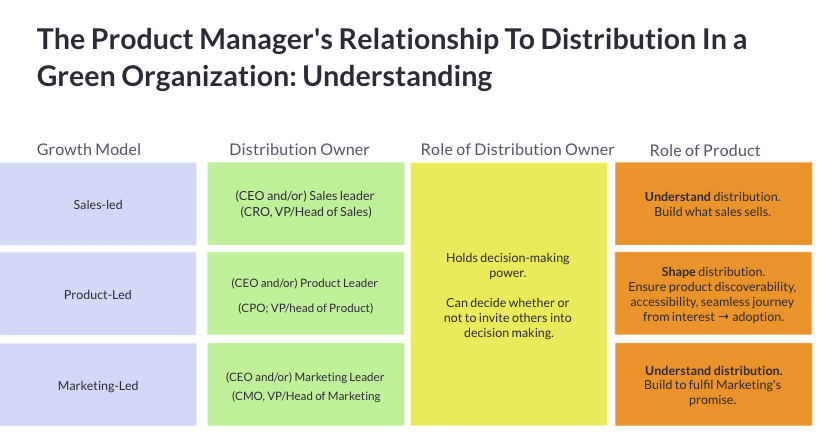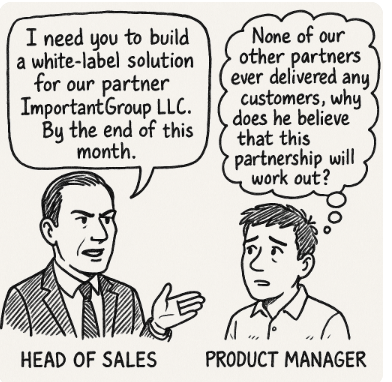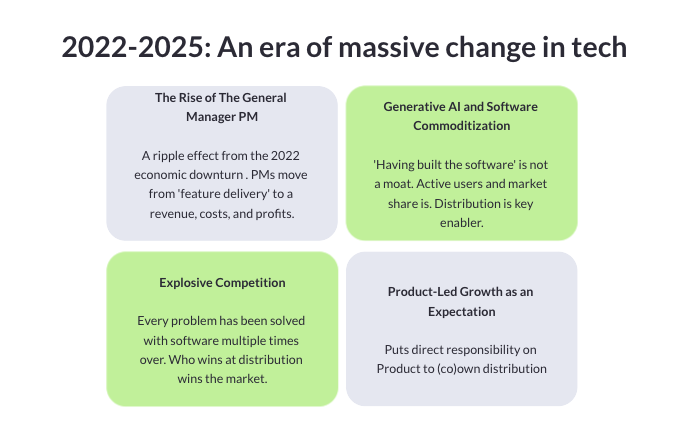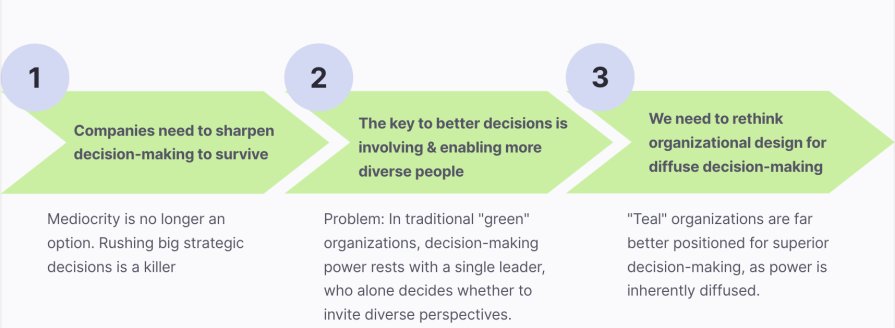
During my 15 years in tech startups I’ve almost exclusively encountered hierarchical, siloed organizations. Sure, employees have been “empowered” and culture trumps structure, but there’s always a pyramid. And within this pyramid, leaders can choose to give up some control, however power isn’t inherently distributed.
The default today remains “stay in your lane.” Frederic Laloux would call these “green” organizations in his book “Reinventing Organizations (…).” In these green organizations, the PM’s relationship to “distribution” tends to be characterized by understanding, instead of playing an active role in shaping it.
While go to market (GTM) is often discussed as something a PM should influence (or even “own,” in some ambitious PM vacancy ads), the reality is that “distribution” — the process and strategy of getting your product into the hands of your target customer — is owned by the CEO and/or the leader of the department acting as the company’s primary growth engine.
Because of this, the product (and every other silo) acts as a service provider to that distribution owner. But what does this look like across growth models? And what role should you really play in relation to distribution?
This article unpacks how distributing power away from the top of your organization enables you to co-architect distribution and ultimately drive more successful products.
When it comes to distribution, the owner and role of product depends on the specific growth model your organization uses:

Here, the sales leader is primarily responsible for product distribution and managing channels. Product’s role is to create what sales sells, prioritizing features that aid sales efforts.
In the best case, the company’s ideal customer profile and the product strategy or vision creates boundaries. In the worst case, the product team implements whatever is asked by whomever.
The product leader is intended to “own” the distribution channel as part of the product experience, ensuring discoverability and a seamless user journey.
However, if the product-led growth flywheel isn’t self-sustaining yet, marketing often plays a larger role in filling the top of the funnel.
The marketing leader is responsible for demand generation through various channels like advertising, content, and SEO.
Product’s role is to ensure that the product is/does what marketing promises. As with sales-led, in the best case you have alignment on ICP, vision, or mission to set boundaries.
In reality, a primary growth driver is often supported by other channels. For instance, a product-led growth company might also heavily rely on marketing to generate leads and sales for product-led sales (PLS) and enterprise deals.
Besides in the model of a fully-functioning PLG motion, product’s influence on the core distribution strategy in these organizations has been limited to adapting the product to match the strategy, rather than fundamentally impacting distribution itself:

That “stay in your lane” attitude harms talented T-shaped individuals, who suffer when they’re sidelined, especially if they recognize a critical company area is failing (e.g., distribution issues) and aren’t allowed to help. As I’ll explore later, it also impairs a company’s ability to make sound decisions.
2022 to 2025 marked an era of massive change for tech companies and product management alike, especially in these four areas:

Distribution isn’t just something that has an impact on what the product looks like; it’s the number one enabler of market success. Given its pivotal role in an organization’s fate, it makes sense to exert every effort to increase the likelihood of making optimal decisions.
In that light, senior PMs merely “understanding” distribution strategies for the purpose of product adaptation is insufficient. Every senior PM requires the skill, expertise, and context to actively co-architect distribution itself.
This is rooted in three premises:
The speed at which new tools and solutions emerge makes it difficult to remain relevant. Brian Belfour writes about product market fit collapse for established companies, but even brand new startups see their ideas get eaten up by dominating players like OpenAI a minute after launching.
This insane pace of innovation demands sharper decision-making. Relying on minor tweaks or endlessly copying competitors won’t cut it anymore. We need big ideas and genuinely strategic approaches.
Since we can’t all afford to hand out 100 million signing bonuses to attract the brightest minds, for most companies the key is to involve more diverse, informed minds into important decisions.
The positive impact of diversity on decision-making is well-established. Diverse groups consistently outperform individuals primarily due to two factors:
Paradoxically, for truly important company decisions, this might mean slowing down initially — investing in involving, upskilling, and informing more people — to ultimately make bigger, more impactful strides.
This premise focuses on structuring the organization to inherently support diverse decision-making through diffused power.
As mentioned above, most traditional organizations are green in Laloux’ book: They emphasize “employee empowerment” and “flat hierarchies” but retain centralized power and silos. He writes that “Leaders might choose to give up some control, but power isn’t inherently distributed.”
Moving beyond this, Laloux’ offers the concept of a “teal” organization as the next evolutionary step. Teal organizations operate with decentralized authority and self-managing teams, empowering individuals to make decisions. Control and power are inherently diffused:

Product Managers and leaders from all departments are expected to contribute.
In a green organization, the distribution specialist (e.g., the founder/CEO, marketing, or sales leader) acts as a sole decision-maker, choosing whether or not to involve others.
In a teal organization decision-making power is inherently diffuse. Product managers and leaders from all departments are expected to contribute to important strategic decisions.
Here, the “distribution owner” role transforms into a:

I recently worked with a 10-person startup that embodied this teal approach. Leaders across sales, marketing, product, tech, and customer success held a deep, mutual interest in all aspects critical to the business. Decision-making for go-to-market initiatives prioritized diverse viewpoints.
Discussions would often conclude with the question, “Do we feel like we have enough context to make a decision?” If not, the team collectively identified outstanding questions and gathered further evidence. There was minimal concern about “stepping on toes” because shared decision-making was the default.
Specialists acted as coaches and context-providers, while still maintaining accountability for ultimate decisions within their domain. The entire team worked towards a shared, focused, and adaptable goal.
At some point during my stint, a senior PM raised his concern that the company was over-relying on partnerships and losing control of the customer relationship. As a result, an evidence-gathering process was initiated to prepare a wider group for a meaningful discussion.
Marty Cagan’s extension of the term Founder-Mode to all product leaders inspired me:
“Another key point that’s often missed, is that at the strong product companies, the senior leaders coach and develop the product leaders that report to them to be skilled in founder mode as well.
One of the biggest misconceptions about scale-ups and large companies running in founder mode is that the CEO is the only one that has this depth of knowledge.
Yet in strong product companies, as you saw in the Amazon Dive Deep leadership principle, every product leader is expected to be immersed in the details, asking important questions, pushing for solid answers, understanding the actual challenges faced and the various approaches being pursued to solve, and more generally developing future leaders (see article here).”
My proposal is that we don’t stop at product leaders but extend all department leaders, and all PMs, to move from a green to teal organization.
So, you might be wondering how you, as a product manager, can actually start helping shape your company’s distribution strategies and/or tactics.
Unfortunately, I can’t give you a simple blueprint because it really depends on your company’s specific situation. But here’s how you can get started:
Distribution — not just product quality — has quickly become the defining factor of success for modern tech products. Simply building great software is no longer enough; the ability to get that product into users’ hands and keep them coming back is what sets winners apart.
This shift demands that you move beyond the traditional boundaries of feature delivery and act as general managers — accountable not only for what gets built, but also for how it performs in the market, how it drives revenue, and how it sustains profitability.
Achieving this kind of impact requires a different approach to collaboration and power. Rather than functioning in top-down silos where leaders selectively invite others into the process, organizations must embrace distributed decision-making. PMs and functional specialists alike must co-architect strategies. It’s no longer enough to understand how distribution works — you must have the confidence and authority to shape and challenge it.
Ultimately, this calls for a mindset shift across the board: every senior product leader must operate in “founder mode.” This means digging deep into the details, thinking critically across the full spectrum of business drivers, and taking ownership of strategy as if the company’s success depends on it — because it does.
Tell us how your organization handles distribution in the comment section below!
Featured image source: IconScout

LogRocket identifies friction points in the user experience so you can make informed decisions about product and design changes that must happen to hit your goals.
With LogRocket, you can understand the scope of the issues affecting your product and prioritize the changes that need to be made. LogRocket simplifies workflows by allowing Engineering, Product, UX, and Design teams to work from the same data as you, eliminating any confusion about what needs to be done.
Get your teams on the same page — try LogRocket today.

Most teams fail at autonomy. Learn how clear rules help product teams move faster without micromanagement.

A practical framework for PMs to use AI in ideation without sacrificing judgment, strategy, or decision quality.

A practical five minute revenue estimation method to help product managers compare ideas, drop low impact features, and prioritize smarter.

A practical guide for PMs who want to stop being bottlenecks, delegate smarter, and lead teams effectively with a clear ownership framework.